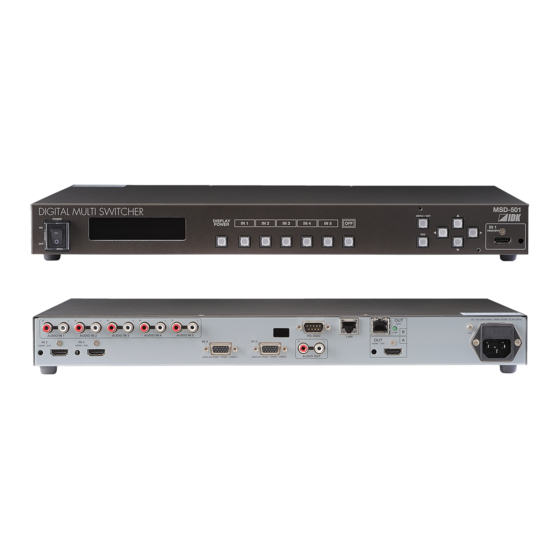
Table of Contents
Advertisement
Quick Links
DIGITAL MULTI SWITCHER
POWER
ON
OFF
DIGITAL MULTI SWITCHER
POWER
ON
OFF
● Thank you for choosing our presentation switcher.
● To ensure the best performance of this product, please read this User's Guide fully and carefully before
using it and keep this manual beside the product.
DISPLAY
IN 1
IN 2
POWER
DISPLAY
POWER
1
2
DIGITAL MULTI SWITCHER
POWER
ON
OFF
DIGITAL MULTI SWITCHER
POWER
ON
OFF
MSD-501/502/701/702
MENU / SET
IN 3
IN 4
IN 5
OFF
ESC
IN 1
IN 2
IN 3
IN 4
IN 5
OFF
OUT 1
OUT 2
DISPLAY
IN 1
IN 2
IN 3
IN 4
POWER
DISPLAY
DISPLAY
IN 1
IN 1
IN 2
IN 2
POWER
POWER
1
2
IDK Corporation
Presentation Switcher
MSD-501
IN 1
HDMI/DVI
MSD-502
MENU / SET
IN 1
HDMI/DVI
ESC
MENU / SET
IN 5
IN 6
IN 7
OFF
ESC
IN 3
IN 3
IN 4
IN 4
IN 5
IN 5
IN 6
IN 6
IN 7
IN 7
OFF
OFF
MENU / SET
OUT 1
OUT 2
<User's Guide>
Ver.1.0.0
MSD-701
IN 1
HDMI/DVI
MSD-702
IN 1
HDMI/DVI
ESC
ESC
Advertisement
Table of Contents

Summarization of Contents
Key Features and Capabilities
Video Features
Lists video capabilities including resolution, cable compensation, switching, and scan conversion.
Audio Features
Details audio capabilities such as A/D and D/A conversion, volume adjustment, and lip sync.
Control Input and Output
Covers RS-232C and LAN for device control input and output capabilities.
Other Device Features
Includes EDID emulation, separate video/audio switching, and key lock functionality.
Device Panels and Interfaces
4.1 Front Panel Description
Details the layout and function of the front panel controls and connectors.
4.2 Rear Panel Description
Describes the connectors and ports located on the rear panel of the device.
Connecting External Devices
5.1 Video Input Connectors
Explains the DVI and Analog video input connectors and their pin assignments.
5.2 Preparation and Cable Requirements
Lists necessary cables like HDMI, DVI, and twisted pair for device connections.
5.3 Connection Precautions
Provides important safety and operational guidelines for connecting devices.
5.4 Example Connection Scenarios
Illustrates typical source and sink device connection configurations.
Basic Device Operation
6.1 Operation Time Requirements
Describes the time taken for communication commands and front panel operations.
6.2 Input Channel Selection
Explains how to select input channels using the top screen or menu.
6.3 Menu Navigation and Operation
Details how to navigate and use the device's menu system with front panel keys.
6.4 Initialization Procedures
Explains how to reset all settings to factory default values.
6.5 Web Browser Control
Details how to control the device remotely via a web browser interface.
6.6 Remote Control Application
Describes using a dedicated application for controlling the device via RS-232C or LAN.
Menu System Configuration
7.1 Menu Structure Overview
Provides a hierarchical list of all available menu options and their sub-items.
7.2 Automatic Input Signal Detection
Explains how the device automatically detects and handles input signals.
7.3 Channel Switching Mode
Configures how input channels are switched (Video & Audio, Video only, Audio only).
7.4 Display Settings: Position, Size, and Masking
Covers adjusting video output position, size, and masking for optimal display.
7.5 Image Quality Settings
Adjusts image quality parameters like sharpness, brightness, contrast, hue, and saturation.
7.6 Input Signal Settings
Configures input signal properties like HDCP, equalizer, and analog signal types.
7.7 Input Timing Configuration
Adjusts timing parameters for input signals, including automatic measurement.
7.8 Output Settings
Configures output parameters like equalizer, output mode, transitions, HDCP, and deep color.
7.9 Audio Settings
Configures audio input and output levels, mute, lip sync, and sampling frequency.
7.10 EDID Management
Manages Extended Display Identification Data for source and sink devices.
7.11 RS-232C Communication Settings
Configures serial communication parameters like baud rate, parity, and operation mode.
7.12 LAN Communication Setup
Configures network communication settings including IP address and operation mode.
7.13 Control Command Management
Manages external device control commands via RS-232C, LAN, or CEC.
7.14 Preset Memory Management
Manages saving, loading, and editing of cross-point and all settings.
7.15 Bitmap File Management
Manages uploading, displaying, and capturing bitmap images.
7.16 Startup Settings
Configures device behavior at startup, including display power and key lock.
7.17 Other Miscellaneous Settings
Adjusts buzzer, power saving, VFD display, and device status monitoring.
















Need help?
Do you have a question about the MSD-702 and is the answer not in the manual?
Questions and answers